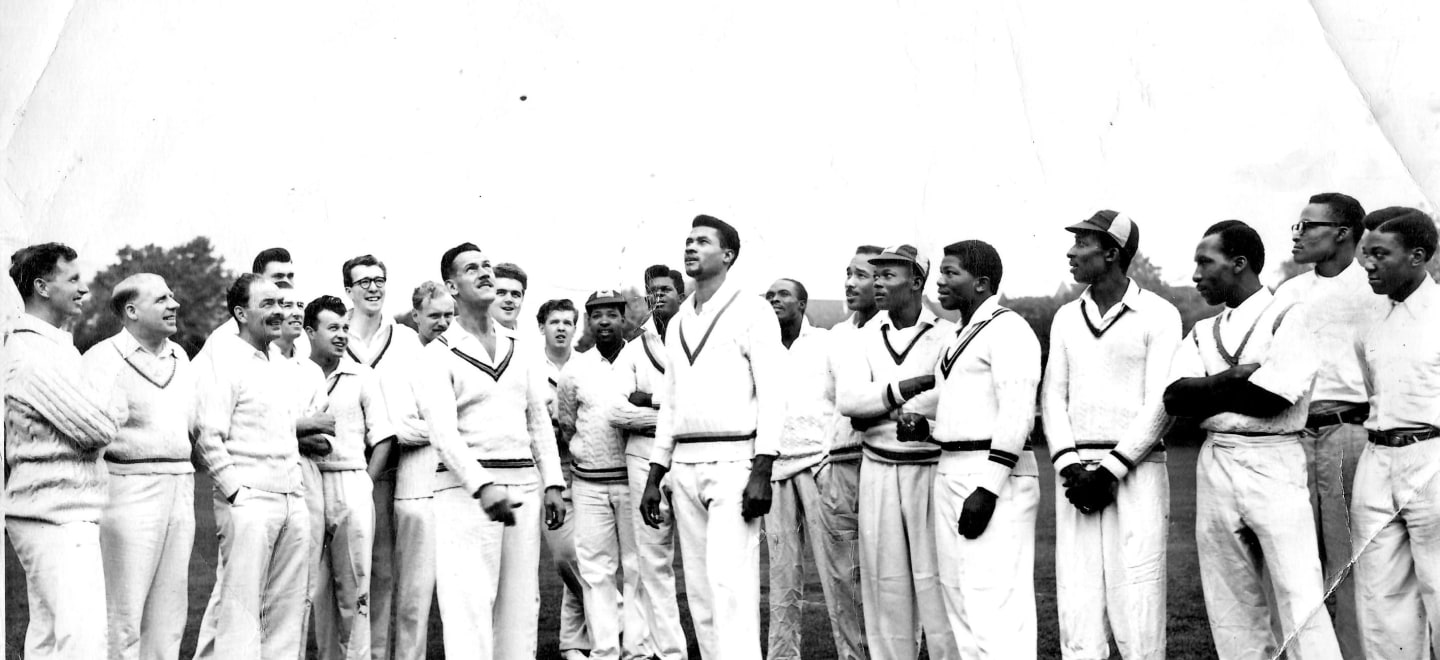PIONEERS OF CARIBBEAN CRICKET

In the afterglow of the historic 1950 Test series between England and the West Indies, what is believed to be the first all-black cricket team in Nottinghamshire was founded.
The West Indies Carib Cricket Club – most often ‘The Caribs’ – had its first base in Long Eaton and was drawn from ex-servicemen that had stayed in the East Midlands after the end of WWII and from those arriving as part of what is now acknowledged as the ‘Windrush Generation’.
Writing in their Thirtieth Anniversary brochure in 1981, Calvin ‘Geroge’ Leigh, a founder member, spoke of “…a spirit of solidarity between most of us which enabled…the idea of forming a cricket team.
“All of us were young men with a tremendous amount of energy, and in the prime of life, so it was not difficult to arrange a meeting…”
Long Eaton was chosen because geographically it was between Nottingham and Derby, the two centres where most young black men were working and living, and was near many of the major employers.
“It had”, reported Leigh, “a black doctor, Dr Denny, who had been in practice pre-war and was well liked and respected in the town, so good race relations existed; and many of us had settled there happily.”
If that first group needed any further impetus, they could look back on the two matches that the 1950 touring side had played at Trent Bridge. In the match against the county XI, Everton Weekes ‘massacred the bowling’ for 279 as the visitors romped home by an innings and 61 runs.
In the Test that followed Frank Worrell, soon to be the first black captain of the West Indies, made 261 – still the highest Test score by a visiting player in a Trent Bridge Test – as his side again wrapped up a comprehensive win, this time by 10 wickets.
That first meeting agreed to form a team to play friendly matches on Sundays – many of the potential team members were already playing for other local teams – and ‘to use the team as a vehicle to promote friendship and understanding among everybody’.
Calvin Leigh continued: “…conscious that we had to embrace fellows among us from different areas of the West Indies other than Jamaica, we agreed to name the team after one of the early people of the West Indies, The Carib”.
This might not have been entirely successful – in his scholarly book, Windrush Cricket, Michael Collins reports that “The numerical domination of Jamaicans…was often a source of tension.
“The Nottingham Caribs, for example, were a team dominated by Jamaicans to the extent that by 1979-80 a separate Caribbean club was set up in the city – the Nottingham Cavaliers”.
A generation further on, and those two clubs have come together and then merged again with Carrington Cricket Club, playing successfully and fielding a wide range of teams for men and women, and for youngsters.
Collins reports one contemporary cricketer as saying that The Caribs were “too good…probably the best amateur team I ever saw, they won everything…but they were ‘too Jamaican’.
The 1981 brochure does admit that there were still some frictions between people from the different island states, especially in those early years, and that cricketers with, for instance, Trinidadian heritage broke away to form other teams.
That early reference to promoting ‘friendship and understanding’ is an important theme in the history of The Caribs, particularly in the late 1950s when racial tensions were high.
“In 1958”, says Leigh, “the Association (a wider West Indian community body) as a whole were aware of minor [hardly] social and racial tension in the City and therefore used the Caribs to play a role in Community Relations Exercises…
“…by arranging matches against the Nottingham University, the Notts Cricket Association and the inmates of Sherwood Prison, Nottingham.
“As a coincidence, on the day we played the inmates, there were racial disturbances in Nottingham”.
In fact, there was a riot in the St Anns district that made national and international news in August 1958. When life settled down, the sort of community engagement pioneered by The Caribs became increasingly important.
One observer, cited by the BBC in 2018, said “After the riots there was a will from everybody that it wasn't who they were, and they didn't want it to happen again.
“Once they started to live amongst each other, they realised they were very similar”.
In 1958, the West Indies Carib Cricket Club were playing friendly matches, though much more regularly than at the start, and it was not until the latter part of the 1960s that the Club was admitted into local league cricket.
Once there – and despite their reputation for good cricket they had to start in a lower Division – they quickly established themselves and rose through the divisions to reach Division One by 1973.
The Caribs finished at or near the top for several years in a row and won the Popkess Cup, the premier knock-out competition in local recreational cricket at the time, at the first time of asking in 1974.
Carlton Forbes, a left arm seamer who had played to great effect for Nottinghamshire between 1959-1973, was a key member of that Cup winning side.
In Black History Month, it is appropriate to remember the pioneers of Caribbean cricket in Nottingham and the important place of the West Indies Carib Cricket Club.
Note: the photograph shows the toss before the 1958 match between the Caribs and the Notts Cricket Association. If anyone can name any of the NCA players, please let the Heritage team at Trent Bridge know: heritage@trentbridge.co.uk .
A copy of Windrush Cricket by Michael Collins is in the Wynne-Thomas Library at Trent Bridge and thus available for any Notts CCC member to borrow (subject to close season arrangements).
October 2025
